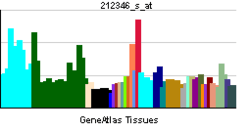MXD4
Max-interacting transcriptional repressor MAD4 is a protein that in humans is encoded by the MXD4 gene.[3][4]
This gene is a member of the MAD gene family . The MAD genes encode basic helix-loop-helix-leucine zipper proteins that heterodimerize with MAX protein, forming a transcriptional repression complex. The MAD proteins compete for MAX binding with MYC, which heterodimerizes with MAX forming a transcriptional activation complex. Studies in rodents suggest that the MAD genes are tumor suppressors and contribute to the regulation of cell growth in differentiating tissues.[4]
References
Further reading
- Rual JF, Venkatesan K, Hao T, et al. (2005). "Towards a proteome-scale map of the human protein-protein interaction network.". Nature. 437 (7062): 1173–8. doi:10.1038/nature04209. PMID 16189514.
- Marcotte R, Chen JM, Huard S, Wang E (2006). "c-Myc creates an activation loop by transcriptionally repressing its own functional inhibitor, hMad4, in young fibroblasts, a loop lost in replicatively senescent fibroblasts.". J. Cell. Biochem. 96 (5): 1071–85. doi:10.1002/jcb.20503. PMID 16167342.
- Pope SN, Lee IR (2005). "Yeast two-hybrid identification of prostatic proteins interacting with human sex hormone-binding globulin.". J. Steroid Biochem. Mol. Biol. 94 (1-3): 203–8. doi:10.1016/j.jsbmb.2005.01.007. PMID 15862967.
- Hillier LW, Graves TA, Fulton RS, et al. (2005). "Generation and annotation of the DNA sequences of human chromosomes 2 and 4.". Nature. 434 (7034): 724–31. doi:10.1038/nature03466. PMID 15815621.
- Gerhard DS, Wagner L, Feingold EA, et al. (2004). "The status, quality, and expansion of the NIH full-length cDNA project: the Mammalian Gene Collection (MGC).". Genome Res. 14 (10B): 2121–7. doi:10.1101/gr.2596504. PMC 528928
 . PMID 15489334.
. PMID 15489334.
- Jiang DJ, Yu HX, Hexige SY, et al. (2004). "Human liver specific transcriptional factor TCP10L binds to MAD4.". J. Biochem. Mol. Biol. 37 (4): 402–7. doi:10.5483/bmbrep.2004.37.4.402. PMID 15469726.
- Ota T, Suzuki Y, Nishikawa T, et al. (2004). "Complete sequencing and characterization of 21,243 full-length human cDNAs.". Nat. Genet. 36 (1): 40–5. doi:10.1038/ng1285. PMID 14702039.
- Strausberg RL, Feingold EA, Grouse LH, et al. (2003). "Generation and initial analysis of more than 15,000 full-length human and mouse cDNA sequences.". Proc. Natl. Acad. Sci. U.S.A. 99 (26): 16899–903. doi:10.1073/pnas.242603899. PMC 139241
 . PMID 12477932.
. PMID 12477932.
- Kime L, Wright SC (2003). "Mad4 is regulated by a transcriptional repressor complex that contains Miz-1 and c-Myc.". Biochem. J. 370 (Pt 1): 291–8. doi:10.1042/BJ20021679. PMC 1223147
 . PMID 12418961.
. PMID 12418961.
- Cairo S, Merla G, Urbinati F, et al. (2001). "WBSCR14, a gene mapping to the Williams--Beuren syndrome deleted region, is a new member of the Mlx transcription factor network.". Hum. Mol. Genet. 10 (6): 617–27. doi:10.1093/hmg/10.6.617. PMID 11230181.
- Billin AN, Eilers AL, Queva C, Ayer DE (2000). "Mlx, a novel Max-like BHLHZip protein that interacts with the Max network of transcription factors.". J. Biol. Chem. 274 (51): 36344–50. doi:10.1074/jbc.274.51.36344. PMID 10593926.
External links
This article incorporates text from the United States National Library of Medicine, which is in the public domain.
|
|---|
|
|
|
(2) Zinc finger DNA-binding domains |
|---|
| | (2.1) Nuclear receptor (Cys4) | | subfamily 1 | |
|---|
| | subfamily 2 | |
|---|
| | subfamily 3 | |
|---|
| | subfamily 4 | |
|---|
| | subfamily 5 | |
|---|
| | subfamily 6 | |
|---|
| | subfamily 0 | |
|---|
|
|---|
| | (2.2) Other Cys4 | |
|---|
| | (2.3) Cys2His2 | |
|---|
| | (2.4) Cys6 | |
|---|
| | (2.5) Alternating composition | |
|---|
| | (2.6) WRKY | |
|---|
|
|
|
|
|
| (4) β-Scaffold factors with minor groove contacts |
|---|
| |
|
|
| (0) Other transcription factors |
|---|
| |
|
|
see also transcription factor/coregulator deficiencies |



 . PMID 8521822.
. PMID 8521822. . PMID 15489334.
. PMID 15489334. . PMID 12477932.
. PMID 12477932. . PMID 12418961.
. PMID 12418961.